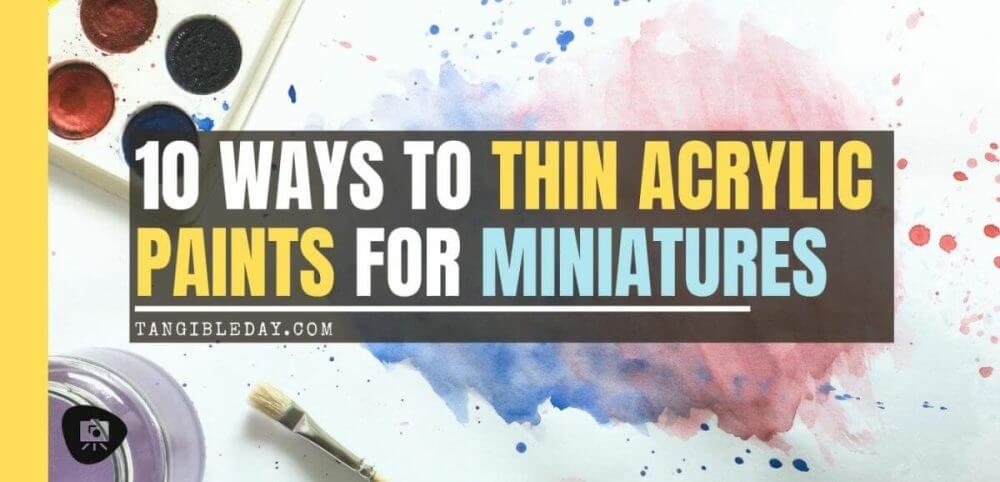How do you thin your paint for painting miniatures and models? Whether you’re painting with Citadel paints, The Army Painter, or other hobby paints, you’ll want to thin your acrylic paints for the best results. The main reason why you want to thin your paint for miniatures is to give you more control over paint flow, and smoother and more even paint application over your models without obscuring fine surface detail. Different model paint thinners have pros and cons you’ll need to consider. Ultimately, how you thin your hobby paints depends on your needs for your miniature project.
In this article, I show you the 10 different ways to thin your paints for painting miniatures and models, and why thinning your model paints is a core technique for a great paint job.
10 Methods for Thinning Paints for Miniatures and Models
Here are 10 different ways to thin model paints for miniatures:
- Water
- Inks and Shades
- Glazing Mediums
- Flow Aids or Improvers
- Varnish (Water Soluble)
- Airbrush Thinner
- Hobby Mixing Mediums
- Windex or Other Glass Cleaners
- Rubbing Alcohol (Isopropyl, Isopropanol, or 2-propanol)
- Slow Drying Mediums
For the most reliable results in miniature painting, you’ll want to know how to balance the advantages of your particular thinning medium with its limitations. For example, some thinners are better for specific color blending techniques, whereas other might be useful for airbrushing or glazing. In general, how you thin your hobby paints significantly affects how the paint behaves on your palette, your brush, and on the model.
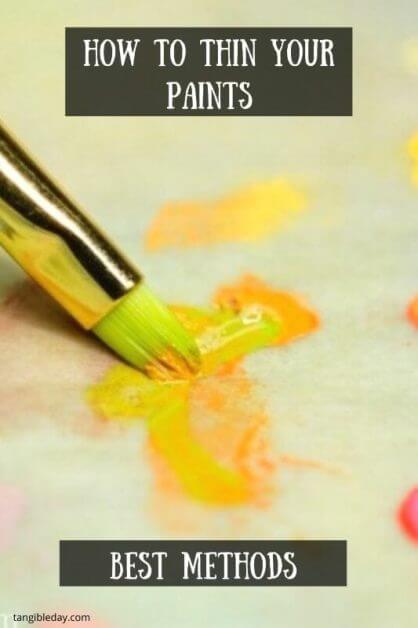
Continue reading for more details about how and why you should use each of these 10 methods to thin your paints for miniatures.
Why do you need to thin your paints for miniature painting?
How thinning your paints will help you in 3 important ways:
- More paint control
- Even, smooth coats of paint
- Surface detail preservation
Thinning your hobby paints to the proper viscosity will give you a lot more control over where your paints goes. You want your paints thin enough that it flows off your brush without dripping or running. A good balanced ratio of thinner to paint depends on several factors (more about this below).
But, in general, mixing a thinner (like water) will help you guide paint where it needs to go. You can use a hobby paint mixer to speed up the process.
For professional results, thinning your paints allows you to create smooth looking paint finishes without the appearance of streaks and brushstrokes on the surface. Thinning model paints allows pigments to settle in finer, layers, give you a lot of control over color saturation, depth, and blending. There’s a good reason that the #1 tip people give to new miniature painters is “thin your paints”. It helps a lot!
As with above, miniatures and scale models often have fine details molded or sculpted on the surface. Layering paint over these details slowly reduces the texture (i.e., filling in the recesses and crevices). If you’re looking to conserve a model’s details, thinning your paint properly will go along way to keeping your model looking “clean” as well helping maintain natural detail contrast.
How do you thin paints for miniatures?
The mechanics of thinning your miniature paints will be the same no matter what medium or additive you use. Here are the basic 3 steps for how you should thin your paints for miniatures and models:
- Place your paint on a clean palette
- Add your thinner of choice
- Mix the paint and thinner thoroughly
First, you take your paint and place it on your palette (more about best paint palettes for thinning paints below). Second, you add your thinner of choice. If your thinner is in a bottle or a jar, you’ll likely need to use a clean brush or an eye dropper to dispense the right amount on your paint (e.g., some thinners come in convenient dropper bottles). Finally, mix thoroughly mix your paint and thinner together.
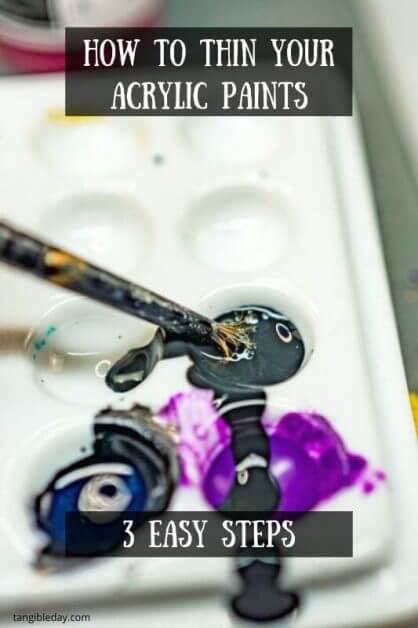
I use the back end of my paint brush (the rounded part of the handle) to mix my paint. If you need to thin your paint further, repeat the process from the step #2 (add more thinner).
For those of you using a wet palette, you may not need to do much thinning. The moisture from the palette will naturally thin out your acrylic paints. Note that there are some risks to over-thinning with wet palettes, so it’ll take some practice.
How do you thin hobby paints for airbrushing?
If you’re going to thin your paint for airbrushing, you should avoid mixing and thinning your paint inside the airbrush cup. After you thin your paint, then use a dropper, a clean brush, or simply pour the paint to transfer your thinned mixture into the airbrush cup. There are exceptions, but for the most part, this will reduce airbrush clogging (as partially unmixed/unthinned paint may get stuck in the nozzle).
Some thinners are specifically designed to help you thin acrylic paint for airbrush applications. What differentiates airbrush thinners from “normal thinners”, is that they contain lubrication and drying retarder, which prevents nozzle cloggings. Vallejo Airbrush thinner is one of my favorite mediums for thinning model paints for airbrushing (and even regular brushwork).
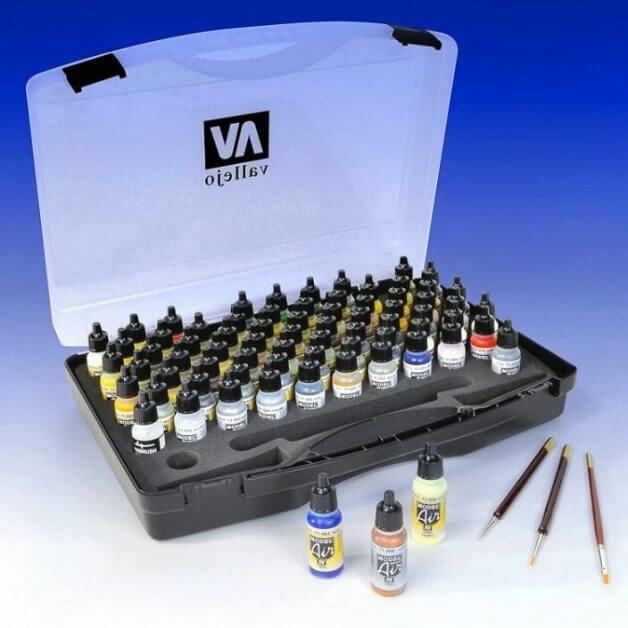
What can you use to thin acrylic paints with?
For hobby or craft acrylic paints, you can use any medium or product that mixes well with water. This is because all model paints with a few exceptions are water-based products. That is, water is the primary solvent for the polymer binder and pigment in acrylic paint. This also means that any medium or additive you use to thin your acrylic paints will also wash off with water (and a bit of soap) should you accidently make a mess.
Continue reading below for the 10 different options you have for mixing and thinning your acrylic paints.
What ratio do I use for mixing thinner with acrylic paints?
I recommend that everyone start with as little thinner for their acrylic paint mix as possible. The more thinner you add, the less paint behaves like paint–You’ll get less coverage, lower color saturation. For the most part, start with a small amount of paint on your palette and slowly add a drop or two to your color. Mix this thoroughly and test whether your mixture is thin enough for your application.
The key is to create a thin mixture where your paint flows off your paint brush, but doesn’t drip or run. Your paint should also maintain its coverage or adherence to the model surface. In other words, don’t add so much thinner than your paint doesn’t stick to your model or working surface. Although some thinners help maintain paint surface adherence, these thinners also reduce the opacity of your paint color.
The exact ratio of thinner to paint you should mix will depend on several factors. This includes how viscous your model paint is already, what thinner you’re using, and what you’re trying to do. For each thinning medium/additive shown below, I provide my recommended mixing ratios for painting miniatures.
Do I need a wet palette or a dry palette?
To thin paints, I recommend using a dry palette. It does take some practice to get into a nice workflow with a dry palette. But, once you understand that paint will dry more quickly and your color mixtures won’t stay wet for a long time, you will begin to see some real advantages with a dry palette. A dry palette allows me to finely control how thin or thick my paint is for a particular project.
A dry palette gives you control for how you thin your hobby paints. You don’t have to contend with a wet palettes’ tendency to soak your paints into a drippy mess. For example, although a wet-palette will help you keep your paints thin, it also has the risk of making your paint too thin.
Paint that is too thin is hard to control, and does not cover surfaces well. This slows you down and can often lead to haphazard mistakes. Additionally, if you don’t maintain a wet-palette, keeping it clean and change out the paper, mold and other nasty things can grow in your paint.
MORE: DRY PALETTE VERSUS WET PALETTE FOR ACRYLIC MODEL PAINTING
Of course, there are tons of advantages of using a wet-palette. As mentioned, your paint will naturally thin out to a useable viscosity. And, your paint will stay wet for a long time, e.g., you will save paint. Finally, a wet-palette is useful for glazing unique colors you’ve mixed together that won’t dry out.
Overall, I continue to recommend using a dry palette for its simplicity in painting miniatures.
10 Methods for How to Thin Your Paints for Miniatures
Here are 10 ways you can thin your acrylic paints:
1. Water
Water is the best universal thinner for hobby acrylic paints. It is the default paint thinner by which you measure all other hobby paint thinners. The biggest reason for why water is the best acrylic paint thinner is that all model paints are water-based products. Therefore, the natural solvent for hobby paints is water.
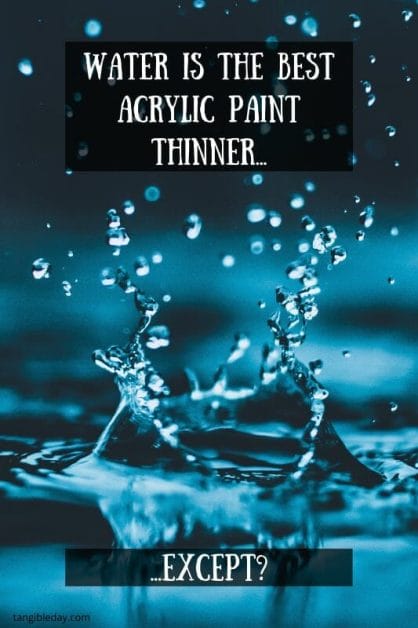
Water is abundant, non-toxic, and free. You can thin all the model paints you want with the water from a faucet tap.
Quick tip: For best results, you can filter your water to remove hard mineral contaminants that may interfere with your paint’s chemistry. You can read more about hard versus soft water in this article.
The limitation of water as a thinner comes from the need to know how much to use. How much water should you use to thin your acrylic paints? The answer depends on many factors, including how thick your paint already is, how pigment rich is your paint, and what you plan to use your thinned paint for, e.g., glazing, washes, or layering. All these factors and more will determine how much water you’ll need to thin your model paint.
In general, you should use the least amount of water as possible to achieve the effect you’re looking to create whilst maintaining good control over your paint flow (a key point as you’ll see below). For example, in normal painting as a default, add just enough water so your thinned paint flows well off your brush as you use it. Note some paints, e.g., Vallejo Model Air, may not require any thinning at all. You can use these airbrush-ready paints straight from the bottle with your regular brush.
Too much water will overly thin your acrylic paints, which does two bad things. First, if you thin your paint with too much water, you will lose the binding property of your paint. This leads to a loss of paint control as you apply it. Your paint will be too runny and won’t go where you need it to go. Paint will drip.
Second, when you use too much water to thin paint, you may end up with a splotchy finish, e.g., coffee stains on your model. This is because the pigment in your acrylic paint will follow the surface tension of the water (pooling at the edges of your brushstroke) instead of spreading evenly through the medium as it dries. In other words, too much water leads to a bad paint finish.
Overall, when in doubt about using water as a thinner, you can follow this rule: the paint should slide from your brush, not drip or clump.
Water
Pros
- Free
- Always available
- Non-toxic
- All natural
Cons
- Easy to use too much
- Risk of splotchy finish
- Makes paint dry faster
2. Inks and Shades
Did you know that you can use inks to thin your acrylic model paints? Inks are different than regular acrylic paints in several ways. For example, inks (and even the hobby grade inks, like Scalecolor’s Inktense or P3 inks) use a liquid pigment or dye for color, instead of the solid ground pigment in normal acrylic paint. Because of this, inks have a much lower viscosity than any regular acrylic paint, yet maintain their color richness.
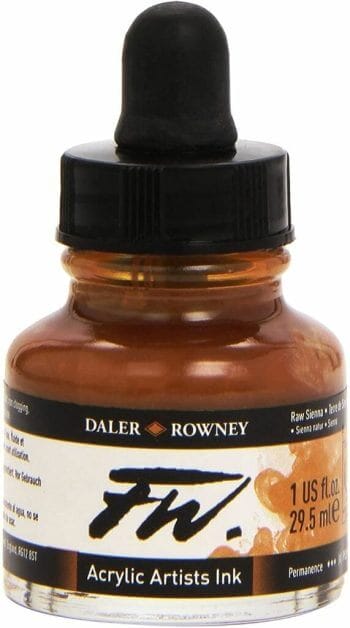
The advantage of thinning miniature paints with inks is that you increase paint flow off your brush without messing with the ability of the paint to cover your models. Additionally, the low viscosity and high color saturation of inks make them a great choice for thinning other acrylic mediums without losing color vibrancy and coverage, which may happen if you thin with simple water (e.g., your paints become too transparent).
RELATED: BEST 15 INKS FOR PAINTING MINIATURES AND MODELS
Of course, a notable limitation of thinning your paints with inks is that you will distort and change the hue and value of your colors. Also note that ink-thinned paints will usually be darker than the original color. This isn’t a bad thing, instead it’s merely a side-effect you will need to account for when you thin paints with inks that have their own color depth.
Depending on the type of ink, the final color and “thinness” of your ink-paint mixture will vary. So you’ll need to experiment with your ink-paint combo for your particular application. Quick tip: Because inks have high color saturation, you can thin inks alone with water and create wonderful glazes that keep their transparency and help you create smooth color blends on model surfaces.
I also find that ink-paint mixing work great for weathering terrain or vehicles. You can create streaky grime, alien blood splatter, or splotches of interesting color on craggy rock faces, e.g., mold and the odd growth, or simply add a bit of interest to a bare warehouse building. Because inks will generally darken a paint color, you can also use inks for shading mid tone base paint colors, which allows you to create natural, more realistic-looking shadows. Give inks a try!
Inks and Shades
Pros
- Fun to use
- Effective thinner
- Retains paint coverage
- No loss in color saturation
Cons
- May distorts color hue and tint
- Darkens paint value
- Requires some artistic experimentation
3. Glazing Mediums
The use of glazing medium for thinning paint is very popular for different reasons. Although, I’ll note here that some glazing mediums actually have more viscosity (e.g., they are thicker) than most hobby paints. For this reason, you’ll want to continue using water along with glazing mediums if you’re looking for a more “thinner” painting experience. Obviously, glazing mediums are perfect for creating glazes with hobby acrylic paints.
When using glazing mediums, less is more. Here’s what I mean: If you add too much glazing medium, you may have paint layers that hide and fill-in small details on your miniature’s surface. So, instead of using pure glazing medium, you’ll want to mix your acrylic paints with just a tiny bit of glazing medium along with water until your paint mixture flows easily from your brush on your model’s surface (not runny or drippy!).

The exact ratio of this glazing medium/water/paint mixture will depend on the type of paint you’re using, the glazing medium thickness, and what you need to do.
As starting point for mixing glazing medium, start with a 1:5 ratio of glazing medium to paint, and thin to taste with water. The great thing about glazing mediums is that mixing it with acrylic paint does not disrupt or dilute the natural binding properties of the paint. You won’t get a splotchy finish and the paint will coat your surfaces smoothly.
Glazing mediums will make your dried paint finish glossy. For most model painting, a matte or satin finish is preferred for an overall complete and professional appearance. A nice matte finish will also make good photography easier, preventing the harsh reflections that can make your models look unfinished or messy. Here’s my favorite matte varnish sealant for miniatures and models.
Glazing Mediums
Pros
- Retains acrylic binding
- Smooths paint finishes
- Mixes well with water
- Great for transparent/translucent glazing
Cons
- Thick viscosity (may require water)
- Risk of filling in surface texture and detail
- Gloss finish
4. Flow Aids or Improvers
Flow aid is a surfactant (or a soapy substance) that breaks up surface tension. For thinning hobby paints, there are a few flow aid brands I’ve tried and recommend. Here are 3 that work great with acrylic model paint: Winsor & Newton Flow Improver, Liquitex Flow Aid, and Golden Acrylic Flow Release. For all of these flow improver additives, you’ll need to dilute them with water (usually in a 1:10 flow aid to water ratio).
The great thing about flow aids is that they can help you in a variety of miniature painting techniques. You can create your own acrylic washes, glazes, or even help you with wet blending in certain situations. Because flow aids are potent, even after you dilute them with water, they will continue to exert a powerful effect on your paints. Use a tiny amount with your paint mixture at a time.
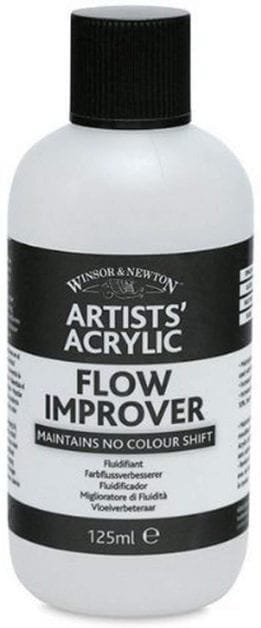
A word of warning when using flow aid in your acrylic paints. Flow aids and improvers are usually toxic and harmful when ingested or inhaled. While licking your paint brush to keep a sharp point is a popular practice, this poses a personal risk when painting with flow aids and improvers. Moverover, although some may suggest using flow aid to thin paints for airbrushing, I do not recommend it. Inhaling aerosolized flow aid can be dangerous. Use an airbrush spray booth to reduce your risk if you must continue, or use a dedicated airbrush thinner medium (see below).
Here are some other practical considerations: flow aids will speed up paint drying. This isn’t really because of the medium itself, but rather that your paint “spreads out” and is exposed to more ambient air. If you’re using flow aids, just remember that you may have to work faster than you usually would.
Finally, using too much flow aid will make your paint much harder, if not impossible, to control. If in doubt, use water first to thin your paints, and a itty bitty dab of flow aid (less than a drop) to get your paints real thin.
Flow Aids or Improvers
Pros
- Removes surface tension
- Dramatically increases paint flow
- Great for making your own washes and shades
- Improves color mixing on your palette
Cons
- Risk of losing paint control
- May speed up paint dry
- Toxic
5. Varnish (Water Soluble)
The conventional purpose of thinners is to improve paint flow and help you create smooth layers, reducing the appearance of brush strokes and retraining surface detail on your model. If paint goes on too thick, you will have a messy, amateur paint finish. The best thinners should also allow you to control where paint goes, too.
Using a varnish to thin your paint has two advantages: First, a varnish mixed with your paint will maintain the acrylic polymer property of the paint, so you don’t lose surface adherence to the model, e.g., paint sticks. Second, a varnish improves the surface reflectivity of your dried model paint. That is, you can mix in a water-soluble matte varnish and create a less glossy paint surface. This really helps for blending different colors through layering and glazing.

Whether you mix a gloss, matte, or satin varnish into your paint, another effect is that varnishes will make your paint colors translucent. This is really helpful for making glazes. In fact, mixing varnishes into your paint is similar in principle to adding a dedicated glazing medium. Both will do similar things, except with a matte varnish, you will have a less glossy surface when dry. Taken together, a varnish can add tons of versatility to your painting toolbox and workflow. You can be more creative.
I use Reaper Miniatures Sealer to help me glaze model paint colors on large or small models, and especially when I want the layers to retain a matte finish as I work. The Reaper Miniatures Sealer is one of my favorite mediums for acrylic glazing and I have a fairly large stockpile of unopened bottles. They are that good!
Of course, make sure you consider adding some additional water to your varnish and paint mixture to reduce your viscosity and improve paint handling off your brush and on your model. As with glazing mediums, don’t use too much as your paint may become too transparent to your liking, and will severely reduce color coverage, which can reduce texture detail on your miniatures.
Varnish (Water Soluble)
Pros
- Similar benefits as glazing mediums
- Adjust your paint finish, e.g., matte or satin
- Helps creates beautiful glazes
- Economical, e.g., a little drop goes far
Cons
- May need to thin with water
- Risk of obscuring surface texture and detail
- Reduces color density
6. Airbrush Thinner
Of all the acrylic hobby paint thinners (other than water), I prefer using airbrush thinners even with regular brush work. Airbrush thinners are similar to flow aids and improvers in that they break up surface tension and greatly improve paint flow. This, of course, helps model paints flow better through an airbrush.
RELATED: AIRBRUSH VERSUS BRUSH: WHAT IS BETTER FOR PAINTING MINIATURES?
The best feature about airbrush thinners, however, as compared with flow aids, is that they slow paint drying. This helps prevent paint from clogging your airbrush. And, it also happens to serve double duty when you’re painting with normal brush on a dry palette or using a variety of wet-blending techniques.
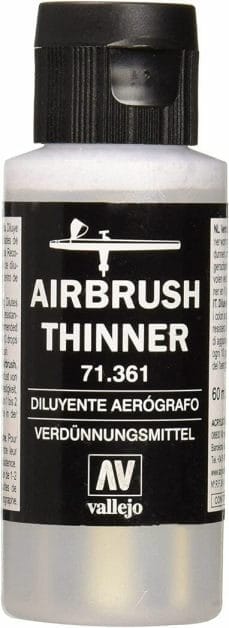
Additionally, airbrush thinners don’t disrupt the natural acrylic binding properties that water will if you add too much. This means that using an airbrush thinner will give you more consistent results in your paint finish. You’ll have an easier time avoiding the “too runny” paint dilemma you may encounter with using water. The exception is that if you understand the correct ratio for using water as a thinner, you’ll be able to do the same thing without the cost of another art medium.
You don’t need much airbrush thinner for most model paints. For example, I use much less airbrush thinner than I would normal water to achieve the same paint thinning effect. This is great because I can maintain color coverage while increasing paint flow, which is something that other thinners can’t achieve.
You’ll want to play around with the best ratio for your application. But, to start, I like using a 1:5-10 ratio of airbrush thinner to paint. If I need to thin the paint further, I’ll either add water or more airbrush thinner. For those wondering what the best airbrush thinner is, I highly recommend Vallejo Airbrush Thinner or Liquitex Airbrush medium. Both work great for model paints, while I’ll note the Liquitex Airbrush medium does add a bit of a glossy finish when the paint has dried.
Airbrush Thinner
Pros
- Easy to use
- Slows acrylic dry time
- Works great for airbrushing or brushwork
Cons
- Water is free
7. Hobby Mixing Mediums
There are a number of specialized mixing mediums that will help you thin your acrylic paints. Some are hobby-branded, others are typical artist grade acrylic mediums (e.g., clear acrylic polymers or binders). Popular and useful mixing mediums that I’ve tried include Citadel Lahmian Medium, Golden Open Acrylic Thinner, Vallejo Thinner Medium, and Liquitex Professional Fluid Medium (matte).
If I had to choose between these acrylic mixing mediums for painting miniatures, I would prefer artist grade mediums for day to day casual miniature painting work. Hobby grade mixing mediums are very effective for thinning and mixing paints, but they are expensive. But, there’s a reason why!
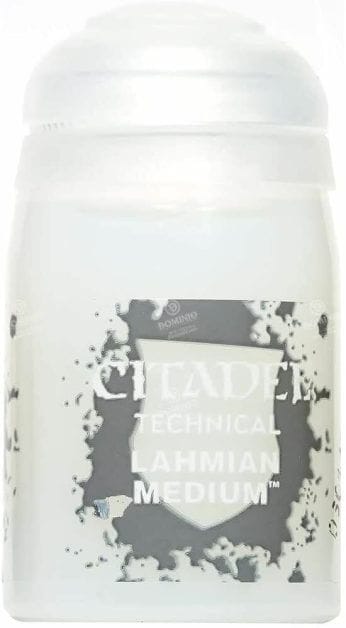
Hobby mixing mediums make up for their expense by being convenient and easy-to-use. Just add a few drops to your model paints and you’re ready to go. The exact ratio you need to mix for your particular hobby paint has already been worked out and there’s no need to make your own recipe. There’s no guesswork involved.
On the other hand, artist mixing mediums require a bit of technical know-how since you may need to additional water and consider that some art mediums will have undesired glossy finishes (even the matte mediums don’t dry very matte when mixed with model paints). You have to experiment for yourself to see what works for your needs.

In either case, whether you use hobby mixing mediums or artist grade acrylic polymer, your paint colors will become more translucent, e.g., less coverage. This is fantastic for glazing and layering approaches for color blending, as well as smoothing out the rough edges on your base coats (with thinned layers of color).
Quick tip: Don’t use mixing mediums for thinning your paints for your first base coat layers. It’s unnecessary. Use water instead, since you’ll be covering up these early layers of color anyway.
For most hobbyists, I would say that hobby mixing mediums are worth the cost as an alternative to simple water for thinning your paints when you want absolute control over your paint thinning and application. Just note that this will eventually become the most expensive consumable in your hobby if you use hobby mixing mediums regularly.
Hobby Mixing Mediums
Pros
- Excellent way to thin acrylic paints
- Creates a translucent paint effect
- Great for glazing and other applications
- Artist grade mediums are cost-effective
Cons
- Hobby brand mediums are very expensive
- Water may work better for most painting needs
8. Windex or Other Glass Cleaners
Glass window cleaners like Windex are both useful and effective model paint thinners. They are the “poor man’s” flow improver, meaning you can find these anywhere, e.g., hardware stores, at the local bodega, and in huge quantities for much less money than the artist grade flow aids. These work fantastic for thinning acrylic paints for airbrushing or regular brush work.
Glass cleaners work well as hobby paint thinners because they break up the surface tension in water-based solutions. This increases paint flow and reduces viscosity in a predictable manner.
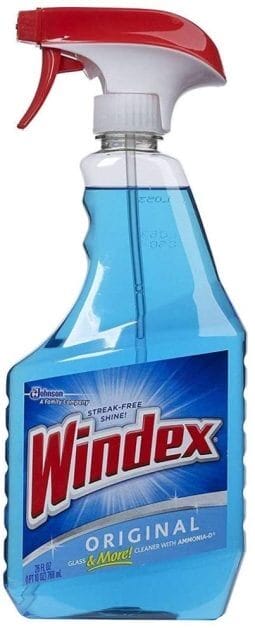
Ever have trouble with your paint puddling, pooling, or clumping on you model’s surface? Household glass cleaners are great at breaking down any oils or contaminants on your model’s surface, which may interfere with the ability of the paint to stick.
I suggest using glass cleaners for thinning paints that don’t have added fragrances, e.g., lime, pine, and other smells. These tend to be very pungent, and annoying float around you for a very long time. Also be aware that almost all glass cleaners have an ammonia active ingredient. Ammonia is toxic and should not be inhaled or ingested. Avoid licking your brushes when using glass cleaners as a thinner and take safety precautions if you’re going to airbrush.
Note that Windex and other similar glass cleaners will also speed up your paint dry time. (The evaporation temperature of windex is lower than water). This works great for cleaning things around your home, but will make some miniature painting techniques nearly impossible, e.g., wet-blending.
Overall, if you want or need to use a flow aid surfecant, but want to save a bit of money, glass cleaners are a useful and effective alternative.
Windex or Other Glass Cleaners
Pros
- Cheap
- Effective
- Versatile
- Use it to clean your stuff, too
Cons
- Ammonia is a toxic ingredient
- Some chemicals may degrade airbrush nickel plating
- Speeds up dry time
9. Rubbing Alcohol (Isopropyl, Isopropanol, or 2-propanol)
Isopropyl, Isopropanol, or 2-propanol (aka “Rubbing Alcohol”) is a less common water soluble thinner for model paint. Interestingly, some hobby metallic paints and inks use alcohol as their solvent/diluent. Can you use rubbing alcohol to thin acrylic paints? Certainly! But for the most part, a reason you may consider rubbing alcohol is because it is easy to find and inexpensive. You may already have a bottle stashed somewhere in your medicine cabinet.
The typical 70% concentration of rubbing alcohol you find at your favorite drug store will easily mix and thin acrylic hobby paints. And, higher concentrations (>90%) of isopropyl alcohol may be strong enough to strip miniature paints from your models. In either case, you won’t need much alcohol for thinning acrylic paints that you want to airbrush or use with a bristle brush. Start with 1-2 drops of alcohol in your paint (1-2 parts alcohol to 5-10 parts paint) and see how it thins your colors.
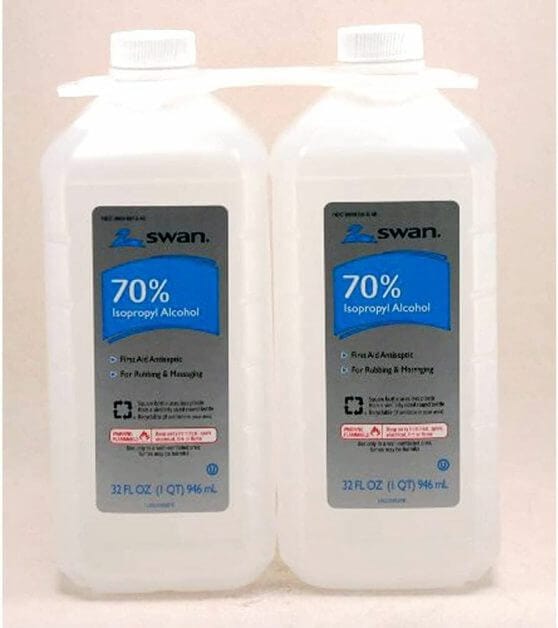
A limitation of using rubbing alcohol as a model paint thinner, however, is that it will significantly speed up your paint dry time. Alcohol evaporates fast at normal room temperature, and as it does, the alcohol will leach the remaining moisture from your hobby paint. This means you should only use rubbing alcohol as a thinner if you already know how and when you will use your paints.
Alcohol is also an irritant to skin, and should not be inhaled if you’re spraying thinned acrylic paint. It is also flammable, so if you’re using a hair dryer in your miniature painting workflow be careful! It doesn’t take much to ignite alcohol fumes. And, when alcohol burns, the flame is invisible (you won’t see the flame melting and setting your hobby stuff on fire, trust me, I know….).
You likely won’t be able to do any wet-blending applications with paints thinned with alcohol. On the other hand, because alcohol speeds up paint dry, you may find it useful for thinning paint for airbrushing. A problem some miniature painters have with airbrushing is having paint that runs too quickly on the sprayed model surface. Alcohol will thin the paint sufficiently to create a nice mist (e.g., improve atomization) and allow you to layer up colors on your model quickly without the runny, spiderly effects.
READ MORE: FREE COMPLETE GUIDE TO AIRBRUSHING MINIATURES AND MODELS
In general, I don’t recommend using rubbing alcohol for day-to-day brush work because of the faster paint dry speed. But, here’s where you may find rubbing alcohol useful with a brush: if you’re looking to dry brush your models, a drop of alcohol in your model paint and a few seconds of airtime will help remove the moisture from your brush (e.g., use a crappy old brush for this application). Then, apply your pigments with the dry brushing technique. Works great!
Rubbing Alcohol
Pros
- Potent acrylic paint thinner
- Useful for airbrush applications
- Inexpensive, abundant
- Sterilizes surfaces
Cons
- Flammable
- Harmful if ingested, inhaled
- Speeds up paint dry time, significantly
10. Slow Drying Mediums
Slow drying mediums are exactly as the name implies; they keep paint wet longer. Slow drying mediums come in many types, from thick gels to thinned clear liquids. In general, if you’re going to use a slow drying medium, you may still need to add water to lower the viscosity of your hobby paint for painting minis.
As with any art mediums, such as Winsor & Newton Slow Drying Medium or Vallejo Retarder Medium, you should start with a small amount and see how it affects your paint. Although slow drying mediums don’t affect acrylic polymer binding to your model surfaces, it will reduce your color saturation through dilution.

My suggestion is to add a drop (or two) and see if that slow down your paint drying enough for your application. Adding water may be helpful as mentioned to lower your paint viscosity further.
The great thing about using slow drying mediums for your hobby acrylic paints is that you can perform more advanced paint blending techniques, such as wet-blending, without rushing as quickly to apply your paint. Of course, on the flip side, slowing down your paint dry speed will slow down your productivity overall. You won’t finish painting your models as quickly if your paint dries slowly after applying each layer.
READ MORE: HOW TO SPEED PAINT MINIATURE AND MODELS
For those looking for an alternative to slow drying medium, you may find a wet-palette useful. Wet-palettes are a hobby device that uses a water-porous film placed over a water-dampened sponge. You place your acrylic paint on the film surface (the palette). As the paint dries, water from the sponge underneath the film seeps upwards, keeping your paint wet for long periods of time.
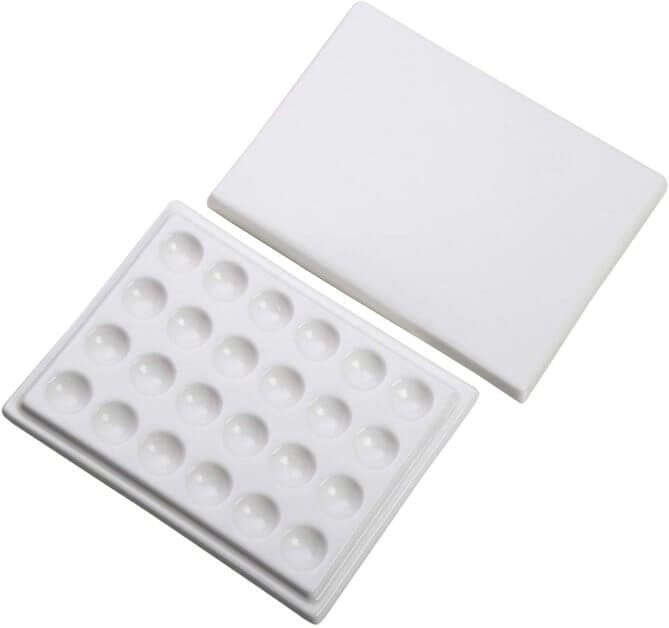
You can make your own DIY wet palette, or buy affordable wet palettes. There are limitations to a wet palette, and I have generally avoided using one for most of my miniature painting work. I tend to prefer using a glazed ceramic watercolor palette for all my miniature painting work. For this reason, I sometimes use slow drying mediums when I paint.
When using slow drying mediums in any setting, you will need to experiment with the exact amount to use. For a start, I suggest using a single drop for every 5-10 drops of acrylic paint (or, 1 drying retarder to 1-5 paint). Mix in some water to reduce the viscosity of the mixture until you’re satisfied. I’ve found that slow drying mediums will increase the time acrylic paints stay wet for up to 30-60 minutes (depending on the ambient temperature and humidity).
Slow Drying Mediums
Pros
- Slows paint dry
- Useful for wet blending techniques
- Versatile for day-to-day miniature painting
- Allows effective use of a dry palette
Cons
- Still requires water to reduce paint viscosity
- Increases the time to complete a painting project
Final Word
The main reason to thin your hobby paint is to give you more control with your brush to apply thin, even coats of paint. Paint that you apply too thickly will obscure details. Although my default recommendation for thinning paint is water, there are other mediums and additives you may want to try. Each of them have advantages and disadvantages, which you will want to balance for best results when painting your models.
I hope you found this article helpful. Although I may have missed a favorite thinning medium or additive, I’m always open to feedback and comments. Until next time, have fun!
Happy painting!



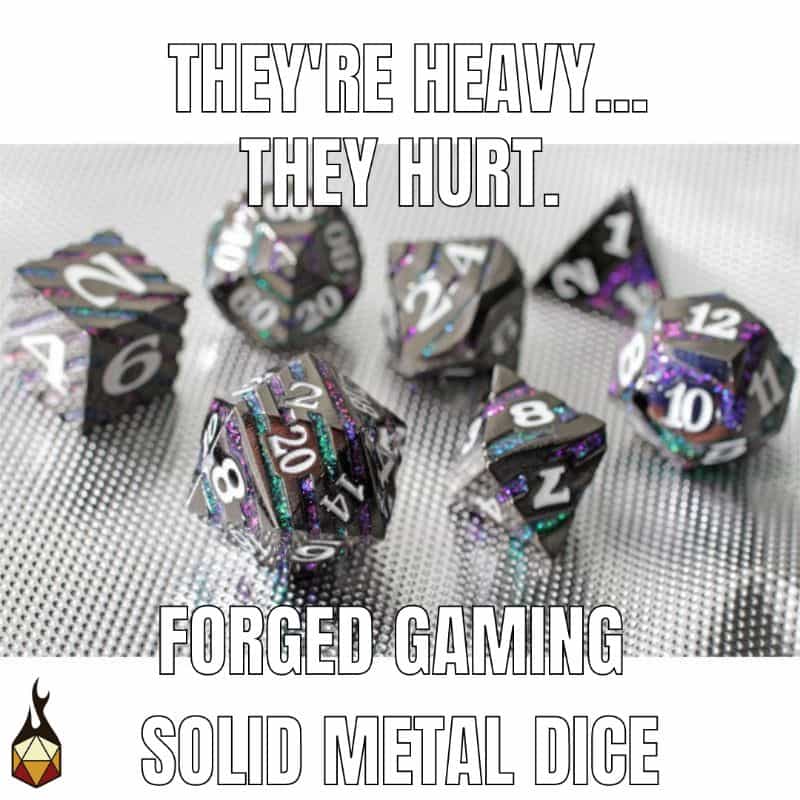

Tangible Day on YouTube (Miniatures and More!)

